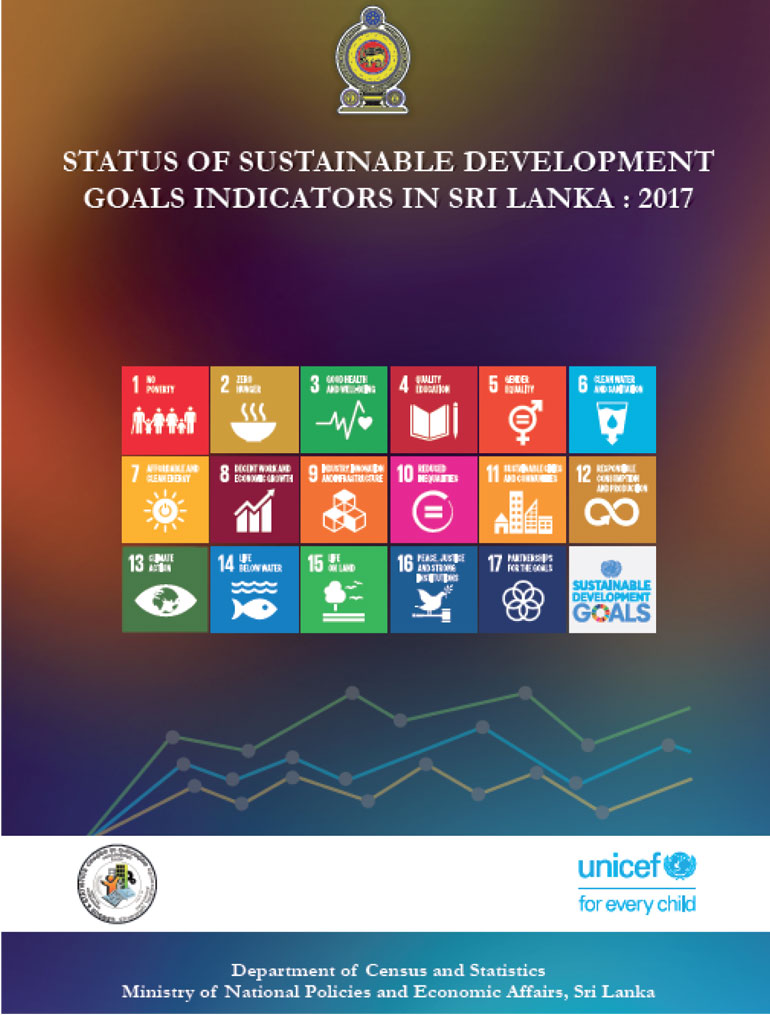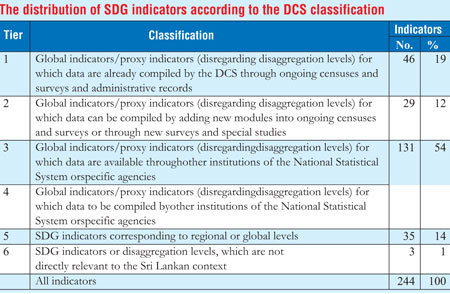Monday Jan 12, 2026
Monday Jan 12, 2026
Thursday, 27 July 2017 00:01 - - {{hitsCtrl.values.hits}}
By Dr. Amara Satharasinghe
The Sustainable Development Goals (SDGs), also known as the Global Goals, are a universal call to action to end poverty, to protect the planet and to ensure that all people enjoy peace and prosperity. The SDGs, officially known as “Transforming our world: the 2030 Agenda for Sustainable Development” are a set of 17 aspirational “Global Goals” with 169 targets and 244 indicators between them to be achieved by April 2030. The SDGs were born at the United Nations Conference on Sustainable Development in Rio de Janeiro in 2012.

The SDGs will guide policy and funding for the next 15 years. The 2030 agenda is a plan of action for people, planet and prosperity, strengthening peace and requiring partnership for implementation. These five elements of sustainable development are all interconnected. The SDGs focus on new areas such as economic inequality, innovation, climate change, sustainable consumption, peace and justice - among others. The SDGs are universal, inclusive and a bold commitment to people and the planet. As in many other countries, Sri Lanka too, in its development agendas is now focusing on Sustainable Development Goals and how it will improve lives while protecting the planet over the next fifteen years.
The commitment of the Government of Sri Lanka (GOSL) is reflected in having a separate ministry on Sustainable Development, appointing a Parliament Select Committee on SDGs, and establishing cluster committees on SDGs etc. The GOSL anticipates achieving the SDGs by 2030 by working towards the provision of basic needs of the people, progressive alleviation of poverty, elimination of all forms of discrimination and inequalities, and establishing a society based on social justice and human security. The Economic Policy of the Government outlines the vision setting the ‘stage for a sustainable development journey’. The Policy aims to develop ‘an economy that will promote the benefits of development among all. An economy that will be friendly to all, beneficial to all. An economy that will pave the way for sustainable development’.
The SDGs represent a people-driven transformative agenda built on the foundations of transparency, participation and inclusion. Achieving the SDGs will depend, among others, on the degree of ownership and engagement of people in addressing them. The SDGs matter to all of us as we have a shared responsibility for our future and that of our planet. Without clear goals and measurable targets, as well as comprehensive data sets that allow analysing the situation, including at the local level, we risk leaving the most vulnerable behind and not properly addressing new challenges that impede development and harm our planet.
Being the key agency in the National Statistical System of Sri Lanka, the Department of Census and Statistics (DCS) has launched a publication titled “Sustainable Development Goals indicators in Sri Lanka: 2017” and the first copy was presented to Thilanga Sumitipala, Deputy Speaker and the Chairman of the Parliament Select Committee recently. Launched together with the publication is a sub website on SDGs in Sri Lanka, which can be accessed through the DCS website: www.statistics.gov.lk. This article highlights the key contents of this publication.
National Statistical System
This publication emphasises the need of institutions other than DCS getting involved with producing data for SDG indicators. In Sri Lanka, What we have is a National Statistical System (NSS). The NSS consists of all statistics-producing entities functioning under the direct responsibility of the government of a country.
The NSS typically consists of the national statistical office (NSO) and any other institutions and administrations that produce official statistics. An effective and efficient NSS that provides regular and reliable data is an important indicator of good policies and is a crucial component of good governance.
The SDG indicators not only require data on areas of enquiry that NSSs have not traditionally produced, they also demand new levels of disaggregation to ensure that we leave No One Behind. What is becoming clear moreover is that the traditional NSS cannot produce all of the data required alone and new actors such as other Departments and Ministries and private sector organisations must now be engaged with and thought of as part of a wider data ecosystem.
Classification of indicators
In this publication, all 244 SDG indicators are classified according to DCS tier system. To facilitate the implementation of the global indicator framework, all indicators are classified into three tiers on the basis of their level of methodological development and the availability of data at the global level, as Tier 1: Indicator is conceptually clear, has an internationally established methodology and standards, and data are regularly produced by countries for at least 50% of countries and of the population in every region where the indicator is relevant; Tier 2: Indicator is conceptually clear, has an internationally established methodology and standards are available, but data are not regularly produced by countries and Tier 3: No internationally established methodology or standards are yet available for the indicator, but methodology/standards are being (or will be) developed or tested. The availability of data for indicators at the national level in Sri Lanka, is not necessarily aligned with the global tier classification and therefore, DCS created its own tier classification for implementation.
According to the DCS classification, indicators (disregarding disaggregation levels and global definitions) for which data are already compiled by the DCS through ongoing censuses and surveys and administrative records are classified as 1. Global SDG indicators/proxy indicators (disregarding disaggregation levels) for which data can be compiled by adding new modules into ongoing censuses and surveys or through new surveys and special studies are classified as 2. Global SDG indicators/proxy indicators (disregarding disaggregation levels) for which data are available through other institutions of the NSS are classified as 3. Global indicators/proxy indicators (disregarding disaggregation levels) for which data can be compiled by other institutions of the NSS are classified as 4. SDG indicators corresponding to regional or global levels are classified as 5. SDG indicators or disaggregation levels, which are not directly relevant to the Sri Lankan context, are classified as 6. The status of the 244 SDG indicators with respect to DCS classification is presented in the table.
Indicator framework
All 244 SDG indicators were classified according to the DCS tier system in this publication. A sound indicator framework will turn the SDGs and their targets into a management tool to help countries develop implementation strategies, allocate resources, as well as a report card indicating progress towards sustainable development, and help ensure the accountability of all stakeholders for achieving the 17 goals. As of April 2017, there are 169 targets and 244 SDG indicators between them. There are 244 indicators listed in the revised global list of SDG indicators. Since nine indicators repeat under two or more different targets, the total number of individual indicators in the list is 235. One use of this indicator framework is to show where the goals are being met and where they are not and focus our attention on the need for immediate action. Indicators falling under Codes 1 and 2 have already been identified and those falling under codes 3 and 4 have to be identified in consultation with Departments and Ministries other than DCS. The complete list of all 244 indicators are included in this publication. Part of the indicators currently categorised as 3 or 4 will be moved to categories 5 or 6. In using the indicators for policy making, the definition of the indicators should be correctly known.

Definition of indicators
UN statistics Division has published the definitions of the SDG indicators and the same definitions are used in the publication as well. If the UN definition is different from the local definition, both definitions are given in the publication. In order to monitor the achievements in SDGs, it is essential to produce base line data for at least prioritised SDG indicators.
Baseline data
Production of accessible, timely, and reliable disaggregated data, and building statistical capacity are essential steps in the process of achieving SDGs. Preparing a publication on the availability of data for SDG indicators is an important endeavour to facilitate establishment of baseline data, monitoring the progress, and reporting the achievements of SDG targets.
The United Nations General Assembly has recognised that baseline data for several of the targets remain unavailable, and called for increased support towards strengthening data collection and capacity building for Member States, to develop national and global baselines where they are non-existent. They committed to addressing this gap in data collection so as to better inform the measurement of progress, particularly for unclear numerical targets.
In Sri Lanka, out of 244 indicators, data are already compiled for 46 indicators through ongoing censuses and surveys conducted by the DCS. The DCS could compile data on 29 indicators by adding new modules into ongoing censuses and surveys. Other institutions of the NSS including various ministries, departments and other institutions need to give leadership in compiling data for some SDG indicators. This publication titled “Status of Sustainable Development Goals Indicators in Sri Lanka: 2017” presents baseline data and details on the availability of data on SDG Indicators through statistical activities of the DCS. Baseline data including year, unit, value, source and frequency of updating for all 46 SDG indicators already produced by the DCS are included in this report.
The cross cutting issue of data disaggregation
Underpinned by the commitment to Leave No One Behind, the Inter Agency Expert Group on the Sustainable Development Goals has stated that “indicators should be disaggregated, where relevant, by income, sex, age, race, ethnicity, migratory status, disability, and geographic location, or other characteristics, in accordance with the Fundamental Principles of Statistics”. Data disaggregation is critical because aggregate level data do not show discrepancies at lower levels. DCS will arrange to disaggregate all its statistics into above levels as much as possible to ensure that Sri Lanka will not leave anyone behind it its march towards 2030 agenda. DCS has launched a website carrying all information discussed here (baseline data, indicator framework etc.) and it can be reached through its website www.statistics.gov.lk.
Website
Through this site, baseline data for 46 indicators can be viewed. By clicking on a goal, the full list of targets and indicators can be viewed. The full indicator framework by goal and target can be viewed in a user friendly manner. This website will serve as a SDG data repository of the country.
Conclusion
The SDGs and their accompanying indicators present both an opportunity and a challenge for Sri Lanka’s data ecosystem. With increased international and national attention given to the importance of data, data producers of the National Statistical System of the country and users have the opportunity to harness the momentum to make lasting improvements. Strengthening censuses and surveys, administrative data systems, and exploring the use of new data would all help towards producing more and better indicators. What is also clear however, is that many of the indicators require cross-governmental and multi-stakeholder participation.
(The writer is Director General, Department of Census and Statistics.)